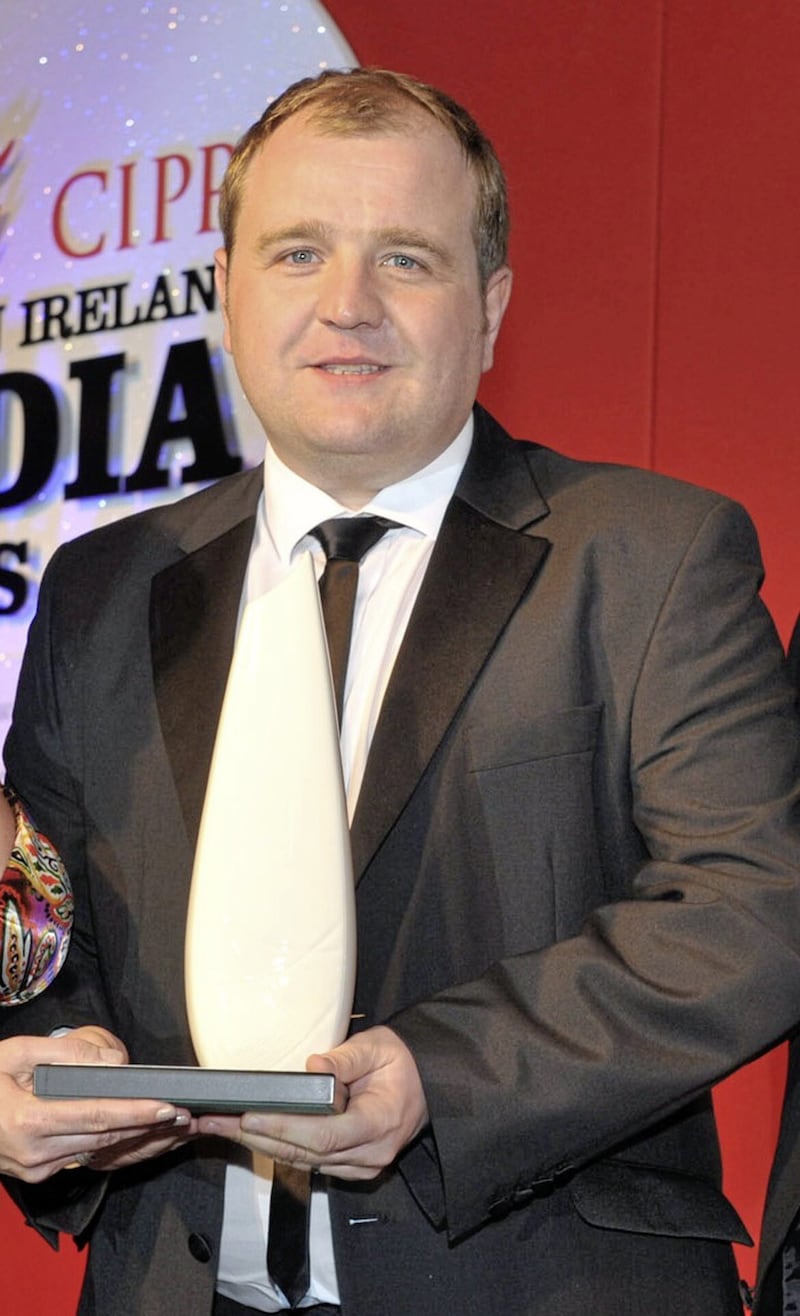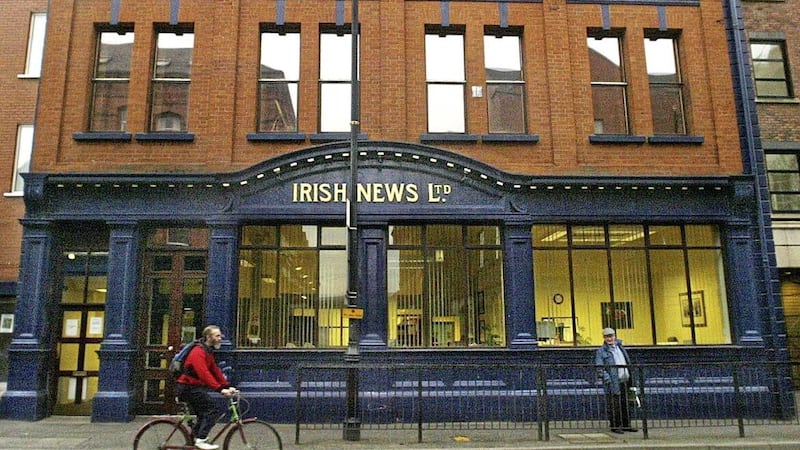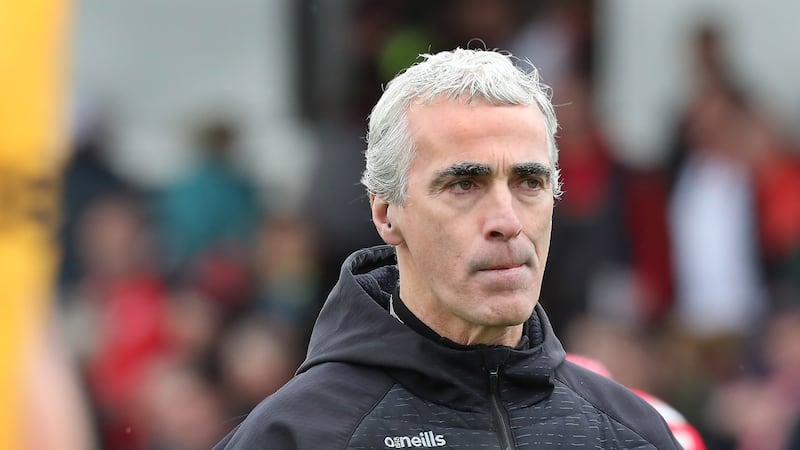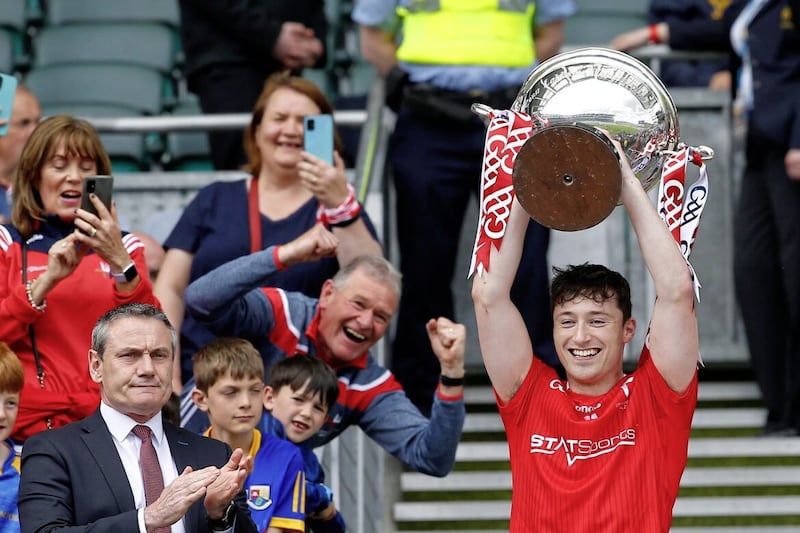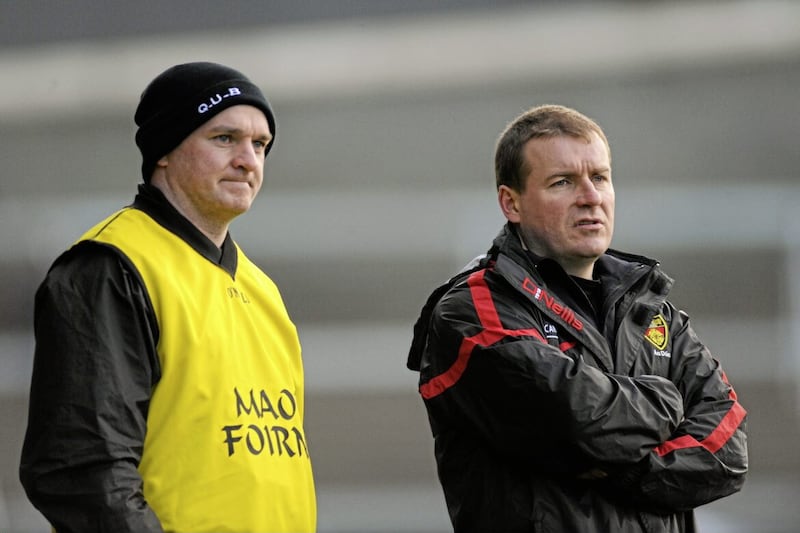THAT six-week placement in The Irish News sports department back in January ’99? I thought I’d blown it.
I was trundling along at the Art College, Belfast studying for a Newspaper Journalism post-graduate degree, trying my best to miss as many of the 9am shorthand classes as possible while still yearning for my Queen’s University days that had wrapped up the previous year.
At that time, Brendan Anderson, a living legend of Donegall Street, had decided to turn his hand to lecturing in journalism.
I could’ve listened to Brendan’s yarns all day about covering the dark days of the conflict for The Irish News and the thousand times he was politely blindfolded, put into the back of a car and driven to a secret location for another exclusive story from the ubiquitous ‘P O’Neill’.
Apart from Brendan’s blue-collar, Belfast wit and stories, I’d no great enthusiasm for the post-graduate course, to the point where I’d skipped enough class time to miss the briefing that a member of The Irish News’s editorial team was coming in to interview those interested in a six-week placement at their nearby offices.
All my classmates were dressed in their Sunday best with their CVs parked under their arms, while I arrived unshaven, wearing a pair of old jeans, grubby trainers and a well-worn lilac-coloured shirt.
The first thing I did when I entered the small room for the placement interview was apologise to Fiona McGarry of The Irish News for not knowing she was coming.
So, I have Fiona to thank for ignoring my desperate attire and taking a punt on an unprepared student.
In January ’99, I turned up to the famous Irish News offices on Donegall Street looking every bit the placement guy.
On my first day, I remember wearing a crisp white shirt and a red and black tie.
It was my father’s tie. He never wore ties either.
I looked like a Crusaders supporter.
I was surrounded by the movers and shakers of local journalism.
The open-planned office was a hive of activity each day. Fax machines rolled, phones jumped and a hundred conversations were going on at once right across the editorial room, half of them probably arguments with press officers.
I had six weeks to make my mark. Those six weeks ended up morphing into 24 years and counting.
I was no more than an average placement student. I remember John Haughey, sports editor at the time, had to write a report on my six weeks in the department.
While John’s few hand-written paragraphs were laced with some decent praise, he described some of my articles as “wooden”. I can still see his awful scrawl on the page.
It's one of the best pieces of criticism I've ever received.
It was good criticism because I could see it myself, but I needed somebody who knew better to point it out to me.
Some of my intros were indeed wooden, probably because I was obsessed with the five Ws at the time – who, where, what, why, when – and trying to shoehorn as much information into a 30-word opening paragraph as possible.
I liked John. He gave me shifts. The first non-negotiable rule of a freelancer is to always be available.
Some days I was given 30 minutes' notice before an evening shift started.
'I'll be in, John. Thanks.'
The newspaper was in the throes of major upheaval. The broadsheet size was being reduced to Euro size, then it later became tabloid size.
Colour was also introduced to some of its pages - and the paper looked better than ever.
It was a confident, buoyant production - made possible by so many people whose professional fingerprints were all over it six days a week and went largely unnoticed by the reader.
The names of the journalists and photographers appeared in the paper, but they were merely the face of the production.
Because I worked day and night shifts, I had the perfect view of the newspaper's intestines and the role of each constituent part.
Ita was a brilliant copytaker and a real lady.
She would sit quietly at her desk every evening and type out the greyhound results from Drumbo, Dunmore, Lifford or Dundalk when they were phoned through.
Ita was calmness personified and word perfect every time.
Often up against unpalatable deadlines, the sports department's chief sub-editor Marty McGoran was the trusted metronome of the evening operation - and still is today.
With the clock ticking, he'd scribble out the sizes of a photograph for the back page, race down to the pre-press room where the late Jim Traynor sat opposite Pat McGreevy.
Jim and Pat were quite the double act.
Pat was like Cool Hand Luke. Unruffled, he'd measure the photograph, send it to Marty and it would be on page in an instant.
At the bottom part of the room, Stevie O'Reilly would call out: 'Straight through, Marty'.
We'd GAA junkies for sub-editors - Chris McCann and Adrian Jones, to name but two - who were perfect for the role, guys who would pick out mistakes and make my articles look better than they originally were for the next day's edition.
The Donegall Street offices were blessed with calm professionals every night, problem-solving, fact-checking and beating deadlines. To this day that remains the case.
I remember willing Paddy Og Nugent to answer his bloody phone to get the Armagh starting team on the back page.
The line crackled: ‘In goal, Benny Tierney, right corner, Enda McNulty, Ger Reid…’
Good man, Paddy.
Throughout the last 24 years, I've met a disproportionate amount of decent people who cared deeply about the product.
From Martina, the consummate office administrator, to Kathleen the librarian who could put her hands on any archive you needed, to the exceptional front of house staff of Lorraine and Roisin, to Margaret producing culinary excellence on the top floor of the building Monday to Friday.
You were surrounded by professionals in the advertising, marketing and photographic departments.
It didn’t matter if you were the editor or a rookie freelancer, Jim Fitzpatrick had time for you.
I remember Yvonne O’Rourke, our retired personnel manager, telling me to take as long as I needed after my father passed away in 2010.
Ah, and Joanne Priest (nae Dale), God rest her soul.
Joanne was full of craic and wit and was absolutely brilliant at her job, a big part of which was putting together the annual Irish News Allstars bash in Armagh.
Those prestigious events ran like clockwork.
We often had our Christmas party in the New Year. Joanne was in charge of the beer tokens.
'Slip us a few more vouchers there, Joanne.'
We never put our hands in our pockets.
The different kinds of people that came through those office doors…
Paddy Heaney arrived in Donegall Street a year after me.
The conveyor-belt of talent coming off the Newspaper Journalism course had obviously stalled.
South Derry meets north Belfast. Wow. A clash of civilisations right there.
On one of his first days, I brought him to Buffalo Bill's, the burger bar in nearby Cornmarket. It was the best £1.30 Paddy ever spent.
'Stick at it, lads,' he'd say on Friday afternoons as we churned out our GAA previews.
I remember we were both posted to Croke Park for a couple of big All-Ireland games in 2008. As the double header drew to a close, the heavens opened and Dublin became flooded.
This was our apocalypse.
We drove around the less affected streets of the capital for what felt like hours and got nowhere. Cars had been abandoned, buildings were irreparably damaged and the Gardai Síochána were utterly helpless with traffic backed up everywhere.
We took a few chances in my champagne-coloured Renault and somehow reached the sanctity of Dublin Airport. Thoroughly depressed and no closer to home.
It was like a scene from Planes, Trains and Automobiles. Like Steve Martin and John Candy sitting in an airport lounge waiting for the water to drain away outside.
The humour had left the room a long time ago.
Nobody battered a keyboard quite like Eamonn O’Hara. You knew he was in full flow when his feet started dancing below his desk.
Frank Bracken was one of a kind. Irreverent and funny, you knew the horseracing pages were beginning to take shape when Frank hammered his mouse like only he could.
The great thing about Frank was the conversation could go in absolutely any direction and you’d invariably be in kinks of laughter afterwards.
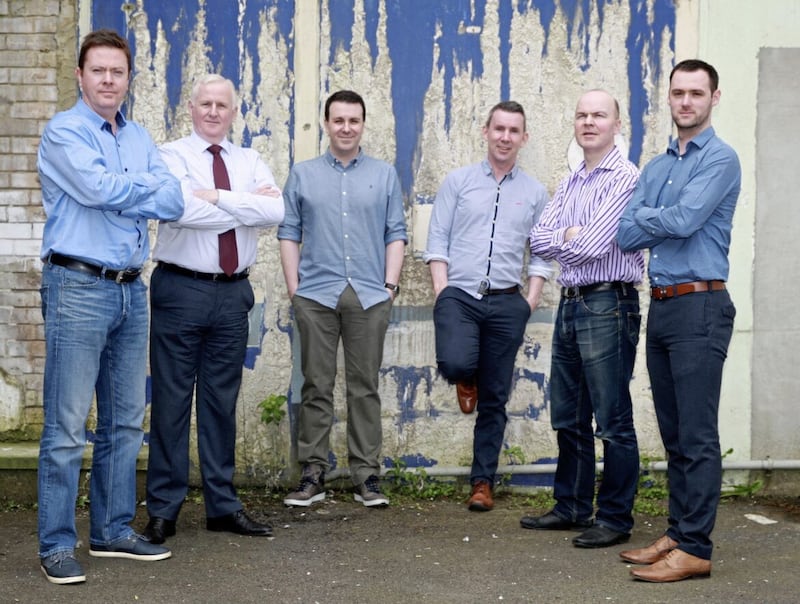
But nobody could beat the Chuckle Brothers of the Donegall Street offices – the inimitable Kevin Farrell and Thomas Hawkins.
Thomas had replaced the outgoing John Haughey as sports editor in the early ‘Noughties’.
I spent two decades working under Thomas – not a bad day among them.
At around 4pm each day, Thomas would hand the editorial reins over to the chief sub-editor for the night. Occasionally it was Kevin.
Within minutes of their editorial discussion about what was going on tomorrow’s back page, the pair would begin chuckling about something.
Another whisper. Another chuckle.
Peering over our computer screens, their shoulders would start to go.
Before their meetings concluded, they’d be in fits of eye-watering laughter, arching backwards in their chairs.
Nobody ever knew what they were actually laughing about but I suppose we didn’t need to know.
This was part of their day and a small part of ours, where a sense of fun and belly laughter had its place.
Some great nights out were had too . Dancing like we didn’t care in the upstairs bar of the Front Page after a Friday evening shift to ‘Message to You, Rudy’ was epic.
And I always loved the uniqueness of Donegall Street: the church goers leaving St Patrick’s on a Sunday night cheek-by-jowl with the Union Street Bar and the Kremlin, all dolled up and permanently ready for another late one.
For 116 years, the imperious Irish News building has been overseeing the physical changes to its fiefdom while itself staying gloriously the same.
A fry with chips in Paul’s Café was divine as city buses steamed down Donegall Street.
Sean Doran leaning against the entrance of the newspaper offices squinting into the afternoon sun watching the world go by.
It’s the summer of 2002 and I’m looking out my hotel room in Seoul, South Korea about 25 floors up completely enchanted by the sea of red on the streets below as the natives cheer on their team - ‘Dae-han-min-guk’ – during the World Cup finals.
In 2004, a motley crew of Irish News employees headed off to Old Trafford to watch Manchester United before flying to Madrid where the furthest we got to seeing Real Madrid and Bayern Munich was outside the famous Bernabéu Stadium arguing and not bowing to the prices of the ticket touts.
Sprawled across two hotel rooms in the Spanish capital, our phones were hopping the next morning.
The Madrid Bombings had taken place, and we’d slept through the whole terrible tragedy.
The years fly by. I’ve had four second-hand cars in the 24 years I’ve worked for The Irish News, each of them having been to more GAA grounds around Ireland than they can remember.
In that time, I’ve retired from playing football, been plagued by hip and back trouble, seen the world, bought a house, got married, become a proud father of two (Rosa and Shea), met work colleagues and sports people who have become firm friends and have generally had a lot of fun.
COVID was our tsunami. For months on end, there wasn’t a GAA match to speak about never mind one to write about - and yet here we all were, in our pop-up offices at home hoping that tomorrow might bring better news.
It was during those dark days I realised the umbilical relationship we all have with The Irish News offices of 113-117 Donegall Street and the unbelievable creativity and resilience my sports colleagues displayed that kept us afloat and relevant.
We motor on into the distance. Nothing stays the same even though we think it will. But change does come.
I paid my last visit to the Donegall Street offices on Monday night as we get ready to move to our brand new offices in Fountain Street in the heart of the city centre.
It felt strange that this would be the last time I’d walk through these rooms, in a building that I spent so much of the last 24 years of my life in, and which gave me so much.
In the mind’s eye, I can still see my grandfather – ‘Scotty’ Logan – standing in the doorway of 64 Balholm Drive in Ardoyne bidding my mother and I farewell.
With a wide smile, he would call out: ‘So long’.
As a child, I thought his farewells were always so heartfelt, even though we’d be seeing him again in seven days’ time.
As I drove out of the carpark at the back of The Irish News building on what was a beautiful Monday evening, I thought of ‘Scotty’ Logan’s heartfelt goodbyes to me every Saturday.
So long, Donegall Street. I loved everything about you...
